Molino Stonewalls Ethics Panel
Myrick, Rosario, Yearwood also asked for Reimagining answers; City drags feet
by Robert Lynch, July 29, 2022; additional reporting posted @ 6:09 PM.
Its seriousness may not rise to that of the January 6th Investigation, yet the procedural similarities are striking and also impossible to avoid.
Citing alleged and inexplicable “conflicts of interest,” former Tompkins County Administrator Jason Molino has declined to respond to questions posed by the County’s Ethics Advisory Board as it seeks information concerning Molino’s and the County’s handling of the Reimagining Public Safety process, Molino’s refusal to cooperate first disclosed Friday morning at a meeting of the Advisory Board.

“I’m not quite sure what to make of his response,” County legislator Rich John, Chair of the Advisory panel said of Molino’s refusal to cooperate.
The Ethics Advisory Board holds the power to subpoena Molino or anyone else who refuses to cooperate with the panel’s investigation, providing the County Legislature authorizes such action. The Board declined to take that step Friday, but could do so when the group next convenes August 19th.
John also revealed Friday that former Ithaca Mayor Svante Myrick, the ex-official at the center of the ethics probe, and two advisors he’d recruited to steer the City’s Reimagining implementation process, Eric Rosario and Karen Yearwood, have also been asked to respond to Ethics Board requests. Because the Ithaca City Attorney, Ari Lavine, refused to serve them directly and forced the Board to locate and serve them itself, neither Myrick nor the advisors have yet met the Board’s deadline to respond. So far, none has done so.
And City Hall, beyond its refusal to forward the Board’s request to Myrick and his associates, is itself dragging its feet. John indicated Friday that Lavine, reportedly acting on behalf of various current City officials requested to cooperate, had described the Board’s search for information as “a very burdensome request,” one Lavine said could not be met by the Board’s earlier July deadline. Lavine said the City could maybe respond by August 31st.
“The clear tenor of their reasoning was one of non-cooperation,” John quoted from an email reply he’d made to Ithaca Acting Mayor Laura Lewis, read to the Board Friday.
“I’m disappointed, but I’m not entirely surprised,” John told the Ethics Board in response to the City’s delay, if not outright refusal to cooperate.
Rather than work closely with the County Ethics Board, Ithaca City officials have chosen to launch their own investigation into the actions of former Mayor Myrick and others which prompted the ethics probe originally requested by First Ward Alderperson Cynthia Brock.
Though ever-expanding in its reach, Brock’s initial complaint centered on Myrick’s paying stipends to Rosario and Yearwood to oversee policing reform duties for which others thought they’d volunteered. Brock alleged the payments were unauthorized. On social media, Myrick has described the ethics investigation as a “witch hunt.”
Intertwined with Brock’s initial complaint were questions concerning the involvement of the non-profit Center for Policing Equity (CPE) and its consulting arm, the Matrix Consulting Group, in the joint City-County Reimagining process. John reported Friday that Matrix had responded to the Board’s request and had supplied “a lot of material,” though he questioned whether much of it is “pertinent to what we’re looking at.”
Molino’s enigmatic non-response left Rich John most baffled. Molino, who was closely involved in the Reimagining report’s preparation in 2020 through April 2021, but then left for other employment shortly thereafter, cited as an alleged “conflict of interest” a conversation he’d had with legislator John earlier this spring. In that conversation, John had asked Molino about the reasons behind the decision to retain CPE. John said it was that conversation that prompted his and the Ethics Advisory Board’s written request for further information.
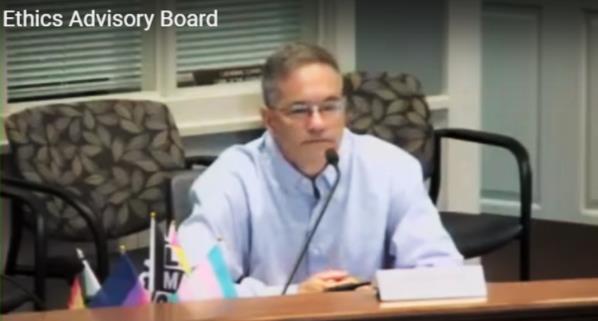
“He responded at that time,” John said of Molino, “and that is the reason I thought it was important that we gave him an opportunity to respond here. But he now says that it’s a conflict of interest in that he responded before.”
“So he didn’t really reply to what we requested,” John told Friday’s meeting.
“I think we can get that information from the County,” John continued. “But I don’t understand the nature of the conflict of interest other than that he doesn’t think he should respond.”
Rich John called his request to Molino a “dead end.” He said he’ll seek the requested information from others in County Government. His first stop will likely be the current County Administrator, Molino’s successor, Lisa Holmes.
****
Other than Jason Molino, no other Tompkins County officials, past or present, were mentioned Friday as among the “interested parties” from whom the Advisory Board had sought information. And other than Myrick, Rosario, Yearwood—and potentially, Mayor Lewis—no similar parties from the City were referenced. A list of those sought to question has not been made public.
While John confirmed the Ethics Board has received materials from Matrix Consulting, as well as from the Park Foundation and a law firm representing the Dorothy Cotton Institute, each of them non-profits implicated peripherally in the Reimagining probe, the Chair confirmed the Center for Policing Equity has not replied to the Board’s information request.

As an inescapable sign of current officials’ unease concerning CPE’s involvement in local police Reimagining, both Acting Mayor Lewis and County Legislature Chair Shawna Black openly announced June 21st that their respective governments had cut all ties with the Center, whose CEO, Dr. Phillip Atiba Goff, has become an outspoken critic of police practices. (See story previously posted on this website, June 26.)
But the Ethics Advisory Board focused its closest attention Friday on City and County officials, not on distantly-linked organizations. Its 30-minute meeting ended with members uncertain whether some high-profile participants in the police reform effort were merely procrastinating in their responses, whether some would need to be subpoenaed, or whether the Ethics Board should simply ignore the uncooperative and seek answers only from willing parties.
Its requests went out in June. Legal custom dictates a response within 20 days. Rich John’s email to Lewis extended the deadline through this weekend. Because of the delays in service, Myrick, Rosario and Yearwood’s timely responses could still arrive by the early days of August. Yet no one on the Ethics Board truly expects a timely answer.
As for Lavine’s suggesting an end-of-August response, the Board’s own counsel, Paul Ferrara, termed that timetable “a bit dilatory.”
And as for issuing subpoenas to compel testimony, “I’d rather we didn’t use that tool yet,” said John. “But we should just have it in the back of our minds that we do have that ability if we need it,” he added.
“Everybody we’re talking to here should have an interest in Good Government and wanting to get a clear, transparent flow of information as to what happened,” John told the Board. “If we don’t get that, yeah, then maybe we should consider subpoenas.”
Subpoenas won’t issue immediately. The Board would first need to request subpoena power from the County Legislature, and the Legislature would need to grant it. The Board held off Friday making its request. So the soonest the Legislature could act upon it would be late August.
What’s more, Board members acknowledged any subpoena they’d issue could not reach beyond state lines.
“It would certainly indicate something to us if somebody left the state to avoid a subpoena,” the Chair remarked.
And so, too, he said, would be lack of candor, even though the only power the Ethics Advisory Board holds is that of issuing an Advisory Opinion, advice that others may choose to either follow or ignore.
“If we believe somebody has deliberately not provided us information or has been obstructive in cooperating with the Advisory Board, we’re able to draw negative inferences from that,” the Chair reminded all listening. “The lack of information is information to some extent.”
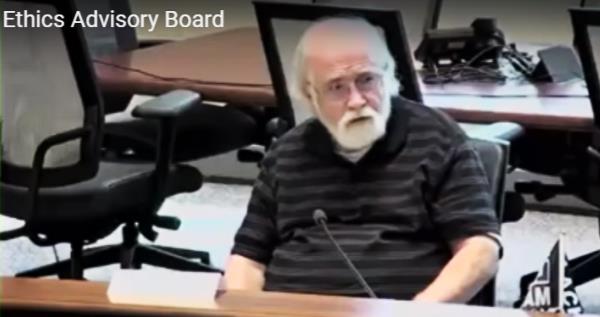
At its Friday meeting, the Ethics Advisory Board could have chosen to review what little information it already had, but instead opted to delay consideration until its August 19th session. Members hoped for more responses by then. Attorney Ferrara recommended members share their opinions only in closed session.
The ethics breaches by Myrick and others alleged so far have only involved sums in the tens of thousands of dollars, money the ex-Mayor contends he was allowed to spend anyway. So some would hope this potential tempest in the Reimagining teapot would resolve itself sooner rather than later.
“I think it’s only fair to everyone to not have this hanging over their heads for any long period of time,” Ethics Board member Brian Eden told Friday’s meeting. “It would certainly be good if people indicated a level of cooperation that we haven’t seen so far.”
###
TCAT takes first step toward Free-for-All

by Robert Lynch, July 29, 2022
It would mark a seismic transformation in local transportation. You’d hop on a TCAT bus, take your seat, and never, ever have to grope for pocket change or a T-Card.
It won’t happen now. It may happen not at all. But the governing Board of Tompkins Consolidated Area Transit, TCAT, took its most significant action to date Thursday (July 28) toward instituting universal fare-free service.
In a Resolution that its nine members massaged for more than an hour—and watered-down with every tortured amendment—the agency’s Board of Directors adopted “the goal of exploring the feasibility of going fare-free.”
The measure further directed TCAT General Manager, Scot Vanderpool, and the Board’s planning committee “to institute a study into the logistics and viability” of going fare-free.
Yes, it sounds overly-tentative. Yes, it reads like a resolution crafted by committee. And that’s because it was.
“I think it’s reasonable to point ourselves in a direction without knowing how this will turn out,” TCAT Board member Jennifer Dotson, one of the Board’s stronger advocates of fare free service, told the meeting.
“I’m not ready to go fare free until I know the feasibility,’ countered former County legislator Frank Proto, one of the meeting’s more skeptical attendees.
While the local transit service eliminated fares May 29th for all youths age 17 and under, and while senior citizens generally pay half-rate, younger adults must still chip in their normal ridership fares. If TCAT eliminated fares for everyone, the change would not likely happen for at least another year.
The Thursday landmark Resolution started stronger—much stronger. And credit Danby legislator Dan Klein, free-fare’s lead cheerleader, for writing it.
Instead of merely “exploring the feasibility” of eliminating fares, as the final Resolution eventually stated, Klein would have had the Board say it “adopts the goal of going fare-free.” Klein would also have had the General Manager “institute a plan outlining the steps involved in going fare-free,” rather than just directing he “study logistics and viability.”
An off-and-on parliamentary battle ensued over the hour with supporters of “plan” on one side; and “study” on the other. The “study” side won, through just barely. Amendments became almost too many to count.
“I do think this decision can wait,” Vanderpool cautioned at one point early in the discussion. “I don’t want to pull the trigger on that (namely a commitment to go fare free) just yet.”
Though Vanderpool has been an early and reliable supporter of eventual fare elimination, he, nonetheless, holds short-term operational and logistical concerns. Since the pandemic, TCAT has fallen short of drivers. More and more buses have been idled in the shop for lack of parts. And simple economics dictates that when fares drop to zero, ridership will skyrocket. Vanderpool fears that his service isn’t ready and won’t be for a while.
Board member Denise Thompson redrafted Klein’s firmly-worded initiative to infuse a whole lot more reticence. On the key amendment of the day, the Board voted 5-4 to embrace Thompson’s “exploring the feasibility” substitute to replace Klein’s more decisive “adoption of a goal.”
“I want it more open-ended,” Thompson insisted. Going fare free may be our goal, she said, but a study may conclude “it may not be something we could or should do.”
“It’s a laudable, overall goal,” Proto told the Board. “I respect Dan’s initiative. But I like Denise’s flexibility…. It may not be feasible for us to do it. We may not be able to pull this off.”
Ridership advocates, some whom have attended recent TCAT Board meetings, have sought eliminating of passenger fares because they view them as inequitable, financially burdensome, and environmentally hostile. Indeed, Thursday’s adopted measure claims fare elimination would improve public access to TCAT’s service, get cars off the road, cut carbon dioxide emissions, and lessen the service’s administrative costs. The resolution claims “dozens of bus systems” in the U.S. have already adopted fare-free policies.
But making the leap in Tompkins County would be a bold move. And for TCAT’s sponsoring agencies, including local governments, it could be a costly one too.
In urging hesitancy, Vanderpool noted that under TCAT’s funding formula, sponsoring agencies must provide a 30-cent match for each bus passenger. And if annual ridership were to rise to four million people—perhaps a third more than at present—Vanderpool warned that local funders would need to chip in $1.2 Million in matching money.
“I’m leaning toward a study,” Vanderpool said, eyeing Thompson’s more cautious option. “It’s great to have a plan in place, but we’ve got to look at this very carefully before we go with this.”
Jennifer Dotson, on the other hand, said being ill-prepared for change is nothing new.
“We have this increase in ridership,” Dotson said, pointing to predictions. “But we don’t want to increase ridership to the point we can’t service it. But we already have a mismatch.”
Over the course of the wordsmithing hour, TCAT Board members sped up the prospective timetable. They called for the feasibility study to be finished within the next 12 months, and not just started by then. Members also involved the Board’s planning committee in the process, rather than delegating it to only the General Manager. The changes signaled the Board’s preference to undertake the feasibility analysis internally, and not retain an outside consultant to do it.
After the final, unanimous vote to pursue the fare elimination study, the TCAT Board went in its waning minutes to committee reports, including to Klein’s planning committee. “Now we have something we can plan for,” Klein said.
###
Tioga St. “Dental Building” likely to be razed
by Robert Lynch, July 21, 2022
When Tompkins County in 2019 bought property in the 400 block of North Tioga Street intending to put an office building there, the two-story “Baker Dental Building” on the lot was valued at more than $1.2 Million. But with plans having changed, and with the building lying idle for most of the time since, the County will likely reduce the 1960’s-era structure to rubble this fall, once it salvages out of it whatever it can.
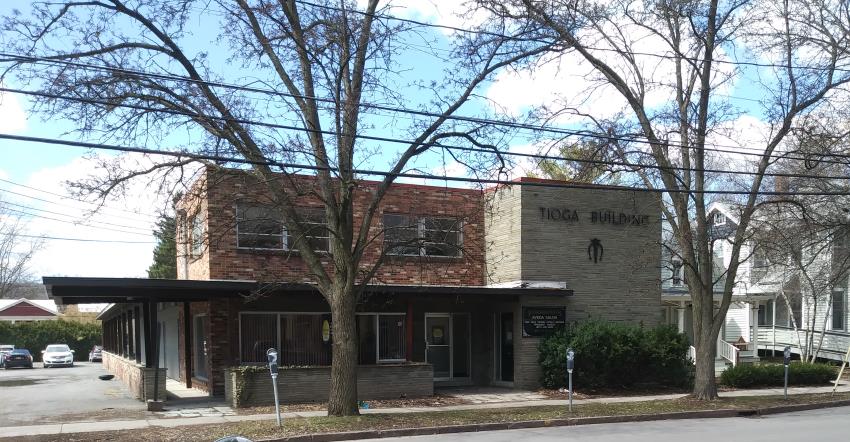
By a 4-1 vote Thursday morning, the County Legislature’s Facilities and Infrastructure Committee recommended the Dental Building be “deconstructed;” the site, once cleared and filled, simply paved over as a parking lot.
“It’s old. It’s exceeded its service life,” County Facilities Director Arel LeMaro told the committee. The Dental Building needs its roof replaced, he said. It also needs to be “brought up to code,” with installation of sprinklers and the like, before it could be used for governmental offices.
“The building is deteriorating,” the Facilities Director cautioned. What’s more, it’s a security nuisance. Last year, he said, trespassers broke in and stole copper.
The recommendation to remove the Dental Building came at a meeting where the Facilities Committee took another step toward consolidating County offices in a “Center of Government,” a four- or five-story structure to be sited on newly-bought land adjacent to the Courthouse. Estimates place the Center’s cost as high as $30 Million.
Since purchase of the Dental Building and its adjacent (largely undeveloped) property three years ago for $1.8 Million, the County utilized the structure only briefly during 2021 as its “downtown testing site” for COVID-19. That use ended more than a year ago. Since then, it’s stood vacant.
LeMaro’s estimates, requested earlier by the committee, put cost of the building’s renovation at $2.36 Million. Deconstruction would cost only $150,000. A half-measure discussed Thursday, one to provide the minimum improvements mandated by code, might total $800,000 to $900,000, LeMaro said.
“I don’t know what other discussion we need,” Facilities Committee member Amanda Champion said, her mind made up for deconstruction.
“I’m not completely opposed to demolition,” legislator Dan Klein—not a committee member—told the committee, “but I’m not in a rush to do it. I don’t think we really imagine all the possibilities yet for this building and all the needs in the community.” Also, envisioning the Center of Government’s likely construction, Klein added, “It would be very helpful to have intermediate space.”
That so-called “flex space” option intrigued legislator Rich John. He noted that if and when the County demolishes other buildings, including its “Building C,” to make way for the Center of Government, it will need interim space for displaced departments. John sought from LeMaro a “limping through price,” to which the Director supplied his mid-level number.
LeMaro insisted the building “doesn’t make sense for flex space.” And he said he would not permit its use for temporary offices absent the upgrades. His argument appeared to persuade legislator John.
But Klein was more persistent. The Danby lawmaker questioned whether the Dental Building could be used for storage by the Board of Elections instead of the BOE’s rented warehouse on Hanshaw Road.
Without elaboration, but saying he agreed with Klein’s assessment, Facilities Committee Chair Mike Lane cast the lone dissent on the deconstruction resolution. The measure will likely see action by the full County Legislature August 2nd.
****
As to the Center of Government, Cindy Kaufman and Quay Thompson of Holt Architects walked the committee through the County’s newly-commissioned Program and Space Utilization Study for relocating governmental offices if a new building were to be built. Relocation would become largely a game of musical chairs. The Holt team outlined three potential scenarios.
Common among those choices would be 1) demolition of “Building C;” 2) the retention of the “Old Jail,” but likely with many new occupants; and 3) a reliance on the presumption that New York State means what it says: that it will pre-empt the entire County Courthouse for its own use and deny it to Tompkins County.
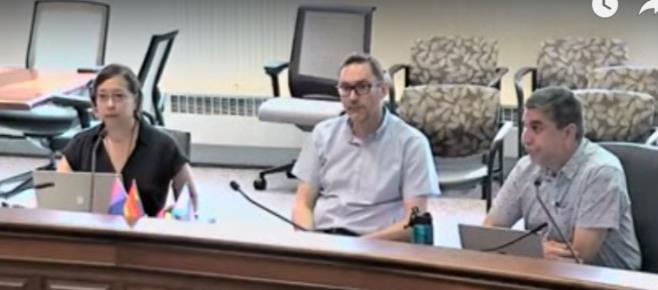
Building C “is at the end of its life and is considered not functional for the future,” Kaufman concluded. But as for the Old Jail, a designated landmark, “We intend it will remain part of the campus, but might have different programming included.”
As for the new building, the architects unveiled no specific designs. But most plans advanced up to now have called for the County to demolish both the Key Bank and Wiggins Office buildings it recently bought and place the building’s footprint there, and perhaps on the site of Building C as well.
If all County government offices were moved to the Center, “it would be one big building,” Kaufman warned. Instead, she predicted, some offices would remain elsewhere. And though the architects included the Motor Vehicle Bureau in their analysis, they quickly dismissed its potential relocation. DMV will likely stay where it currently is, in a plaza off Hancock Street.
The main difference among the three Holt scenarios presented the committee was that the most ambitious alternative would close the County’s Human Services Annex at West State and Albany Streets and put the renovated former Western Auto store up for sale. If the County did, the Center of Government next to the Courthouse might need to be five stories high, not just four.
Mike Lane asked about parking, recognizing that workers at County offices downtown often have nowhere to park.
“We did not perform an in-depth parking analysis,” Kaufman conceded. Yet rough estimates indicated that the first of its options would add 33 employees to downtown; the intermediate choice, 51 people; and the most ambitious option, 61 employees. The predictions did not consider parking for visitors.
That’s going to mean “a stronger need for parking on the street or even going over to the parking ramp,” Lane warned. (Note: By the time the Center would be built, the Seneca Street parking ramp might then be gone.)
Groton legislator Lee Shurtleff worried about shortchanging the future, suggesting at one point that the optional fifth floor might prove useful for expansion.
“We tend to build things for what we need today and then end up shooting ourselves,” Shurtleff said.
Architect Kaufman responded by stressing the need for what she called “flexibility and fluidity.”
“We don’t want an ugly building,” Kaufman said. We don’t want a building “too big for the site.”
The Facilities and Infrastructure Committee took no action on Holt’s Space Utilization Study. Instead, it passed it along to the full Legislature, albeit with some uncharacteristic reluctance.
“I think we need another discussion here in this committee before we send it on to the Legislature,” Lane remarked. Nonetheless, the PowerPoint slides presented by Holt to the committee Thursday had already been uploaded onto the County’s website at the time of the meeting, and the meeting’s video remains viewable on YouTube. Only the bulky backroom appendices might still be shielded from public view.
“I’d like to see the full Legislature have this information,” Ulysses’ Anne Koreman requested.
Amanda Champion obliged Koreman’s appeal. That said, she cautiously added, “Maybe you don’t want everyone starting to weigh in.”
###
Legislature hardens Human Services Security; delays tough Redistricting vote
by Robert Lynch, July 20, 2022
“This is a failure on behalf of the City of Ithaca,” Dryden legislator Greg Mezey said without hesitation Tuesday night, moments before the Tompkins County Legislature, without objection, approved measures to turn the entrance to the County Human Services Building into something it’s never before been; an entry where armed police and magnetometers screen those who walk in.

Under the County Legislature’s beefed up security at the four-story West State Street building, two armed Sheriff’s deputies will be assigned to screen visitors, with a metal detector installed to guard against weapons. The annual cost of the officers alone could top a Quarter Million Dollars. Officials hope New York State will reimburse 70 per cent of the expense.
Though the decision to effectively “harden” the Human Services Building‘s security was fully expected, virtually every lawmaker who addressed the issue Tuesday voiced a reluctance with having to act; both for changing the open nature of the facility and in finding themselves forced to respond to the City of Ithaca’s perceived inability or unwillingness to adequately police the neighborhood.
“I think initially going into it, I was a little bit apprehensive about getting the metal detectors and armed officers in the building,” Legislature Chair Shawna Black told Tuesday’s meeting following her tour of the Human Services Building with a fellow lawmaker. “But it really seems like we need to take this step in order to offer security and a sense of safety for our employees.”
And as for visitors, Black added, “We want them to feel welcome, and we want them to feel safe…. It’s a sad state we’re in right now. But I think the protection for everyone and the safety for everyone really has to be at the forefront.”
Security concerns at the Human Services Building heightened in late-May when two people were shot and wounded at a West Seneca Street residence a short distance from the County’s offices. A few days later, another person was stabbed on the sidewalk a short distance from the building’s entrance. At a County Legislature meeting shortly after the incidents, County Administrator Lisa Holmes told lawmakers the twin incidents left some of those who work at the building “feeling stressed and traumatized.”
“It’s not a comfortable place to walk around,” Newfield legislator Randy Brown told Tuesday’s meeting after having taken a stroll down West State Street. “You feel the uneasiness when you’re down there.”
And Brown said that when he visited the area, he found little, if any, police presence.
“This is yet again another example the County picking up the tab for something the City of Ithaca doesn’t want to deal with,” Dryden’s Mezey told the meeting. “We have a responsibility to see if there’s a way we can hold them accountable…. It’s time that the City wake up and start actually doing something about it.”
The Dryden legislator urged Ithaca’s Acting Mayor and Acting Police Chief to explain themselves before the County Legislature. Chair Black said she’d invite them.
The County Human Services Building houses both the Social Services and Probation Departments. Each serves disadvantaged people, and legislator Travis Brooks maintained some of the security problems originate not just outside the building, but also inside it, with patrons angry and frustrated at the system.
“Until we can get some commitments from the City to clean up that area, the outside is going to stay the outside,” Brooks said. “And as long as people are hurting the way they are, we’re going to have folks coming in there and being very upset and angry about the response that they’ve been given.”

Lawmakers like Lansing’s Mike Sigler regret the Sheriff’s Department needs to be involved in building security at all. Some, like Sigler, might prefer retaining a private security service, at a presumed cost savings. But objections by deputies’ unions elsewhere suggest that only county employees may guard county buildings.
Although raised briefly at a committee meeting July 7th, the private security option received no serious discussion before the full Legislature Tuesday.
“The Sheriff’s Deputies are not for our personal safety,” Sigler remarked. “I look at deputies as securing the entire community, not just a little section of it.”
Still some, including Sigler, broadened the issue further.
“If the City doesn’t want to have a police force, that is going to fall on our shoulders,” the Lansing Republican asserted, questioning whether a downsized—and some suggest, demoralized— 50-officer Ithaca Police Department stands up to the job.
“Mike Sigler, some of us have thought we needed County Police for many, many years,” Dryden’s Mike Lane replied, Lane reviving the idea of a City-County police merger that’s lain dormant for years.
And then there’s the Reimagining debate and how much money County Government should invest into a downtown neighborhood that some see as less and less safe.
It’s a “sad irony,” Groton’s Lee Shurtleff observed. Reimagining Public Safety, Shurtleff said, has encouraged unarmed response, “and here we are in the busiest facility that our County government operates arming our responders.”
“Don’t take this as a slight,” Shurtleff continued, “but Reimagining Public Safety maybe isn’t what we’ve really been doing. We’re reimagining policing…. Some of our governments have gotten away from what to police and where to police. This pains me to vote for this Resolution. We’re off the track here.”
Without stating it outright, Shurtleff, a former County Director of Emergency Response, hinted that the County might want to rethink constructing a more than $20 Million office building downtown, just a few blocks away from the Human Services Building; that is, if City Police can’t keep downtown safe.
“We’ve got to be rethinking a lot of things here,” Shurtleff said in frustration.
Though, technically, Tuesday’s vote imposes the Deputies and metal detectors only until year’s end, most expect the security practices this fall to be budgeted into the next year.
****
A late-meeting issue that was expected to draw County lawmakers to opposite corners Tuesday night instead, after some initial discussion, got tossed ahead to the Legislature’s next meeting. County legislator Lane advanced his own Resolution which would have remanded an independent commission’s 16-legislator redistricting option back to the commission for requested retooling. Lane would like to see the commission pare down its 16-member plan to 15 legislators or fewer, and keep membership at an odd number to avoid tie votes.
Lane’s alternative lost by one vote in committee to the Independent Commission’s 16-member proposal. Though the County Charter allows the Legislature to send a recommendation back—but only once—nothing stops the Commission from handing its original recommendation back to the Legislature unchanged.
Both legislators Randy Brown and Travis Brooks have joined Lane in his effort. Brown has predicted a close vote. And while that vote will likely occur, it won’t take place for another two weeks.
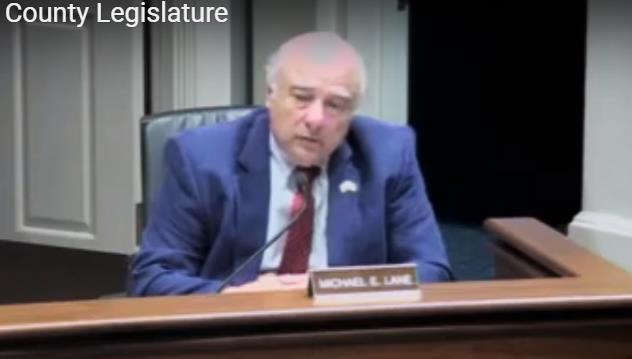
After some initial talk, including whether consideration of Lane’s request would put the cart before the parliamentary horse, the Legislature voted to table the remand Resolution until August 2nd. Governmental Operations Committee chair Amanda Champion also agreed to postpone her request to set a public hearing on the Commission’s own redistricting scheme, the one backed by her committee.
Mike Lane needs eight votes to send the proposal back to the Commission. And Tuesday’s discussions revealed he’s already gotten six. Enfield’s other legislator, Anne Koreman, added her likely vote to Brown’s in support of Lane’s effort. Ithaca’s Rich John and Danby’s Dan Klein also jumped on board. Fewer than six have committed to oppose Lane’s request at this point. Other legislators remain mum.
“I don’t think there’s any harm in getting a different look at it,” Rich John Said. John has concern that his own redrawn Ithaca district would attach “the middle of Cornell” to Collegetown, together, he maintains, containing “very, very few long-term residents.”
Koreman, meanwhile, worried that another City district had succumbed to “gentrification.”
As for Klein, though he generally likes the Commission’s 16-member draft, he said revisiting the maps does no harm. It’s “not hurting anything and we have no time pressure,” Klein maintained.
Chair Shawna Black, for her part, urged constituents to engage in the process. If they don’t, she said, “it’ll be a wild goose chase, and it’s going to be time wasted.”
###
T.C. Pols Back 2nd Amendment Rewrite
by Robert Lynch, July 20, 2022; additional reporting Wednesday at 3:05 PM
Think of it this way: If the Tompkins County Legislature were Congress, a rewrite of the Constitution’s Second Amendment would now be on its way to the States for ratification. And for that matter, were each County lawmaker a State Legislature—presuming there were only 14 states in the Union—what those local lawmakers adopted Tuesday night would now become the Law of the Land.
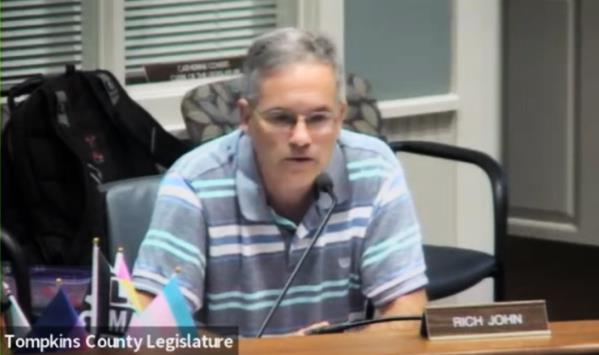
As the final piece of major business at the close of a marathon, five-hour meeting, the Tompkins County Legislature Tuesday adopted by an eleven-to-three vote—a 78.5% margin—member Rich John’s quickly-filed Resolution that would simplify and modernize the Second Amendment. John’s revision, while keeping the amendment succinct, would remove the largely outdated wording about “militias.” But more importantly, it would add language permitting the federal government and the States to impose “reasonable” gun regulation.
“You can’t ignore the regular news reports of these horrendous incidents that seem to just be happening more and more often in our community,” John told his colleagues, “and I bring the Resolution because I don’t know what else to do. I think this is something we should speak to.”
As adopted by the Legislature, John’s new Second Amendment would state:
“The people shall have a right to keep and bear Arms. The reasonable regulation of that right shall be delegated to the federal government and the individual States.”
The County Legislature endorsed Rich John’s rewrite by a party-line vote. All Democrats supported it. The body’s three Republicans, including Newfield-Enfield’s Randy Brown, opposed it.
One of the Republicans, Lansing’s Mike Sigler, while commending John for bringing the revision forward, argued the change would only strike a glancing blow at the crime problem, would ignore that Sigler maintained was a century of consistent Second Amendment interpretation by the Supreme Court, and would set “vague” standards to boot.
“I don’t think this actually solidifies or clarifies the Amendment at all,” said Sigler. “Where do you go with regulation? It would almost make more sense to kind of ban firearms or something,” an extreme measure the Republican made clear he would not support. “There’s no ambiguity there,” Sigler said of a hypothetical firearms ban.
Dryden Democrat Mike Lane predicted that if Congress ever recast the Second Amendment, it would never be as simple as the two-sentence substitute John had offered.
“It would be rewritten and rewritten and rewritten and fought over before it ever got to the States,” Lane said. “It’s a long way to get there, and it’s going to be very, very hard.” Nonetheless, Lane voted for the measure as “doing something.”
To ever become law, barring a convention of the States, a constitutional amendment would require two-thirds support in each house of Congress, and then ratification by three-fourths of the States, a margin of support that Tuesday’s County Legislature vote would have accomplished.
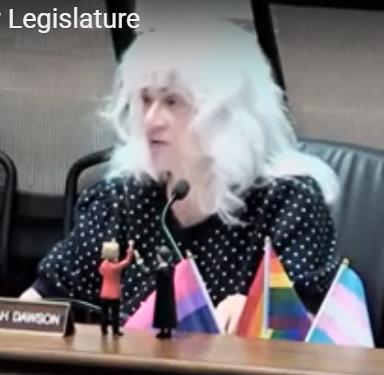
Everyone acknowledged how hard that kind of constitutional change would be, especially given Washington’s polarized politics. Lansing’s Deborah Dawson, a hard-nosed, white-haired lawyer, equated legislative passage with her being crowned Miss America.
Nonetheless, Tuesday’s Resolution will be forwarded to local State and federal representatives for their review.
For Democrats, principle clearly governed the moment, while Republicans would focus on problems closer to home.
“The Second Amendment, as written, is an anachronism,” said Ithaca’s Veronica Pillar, perhaps the Legislature’s most activist member, “and we don’t need to worship it word-for-word centuries later.”
For Rich John, leaning on the Second Amendment’s textual prohibitions is to rely on only a “hollow answer” to solve a pressing problem.
“If you’re a carpenter, you certainly have an obligation to take care of your tools, because they’re your tools of your trade,” John said. “But they’re tools, and you can never lose sight of the fact that tools work for the carpenter, not the other way around.”
“The Constitution,” Rich John argued, “is a tool for government. It’s pretty straightforward that way.” In his view, if the tool isn’t working, then change it.
“We cannot make sense of these words to the extent that we can reach a national consensus,” the legislator observed of the Amendment’s current phrasing. “So I say let’s vote to change the words.”
Republican Brown, on the other hand, asserted that rather than amend the gun laws or the Constitution, the federal government should “start with the laws that we have and make sure they are imposed.”
And the Legislature’s third Republican, Groton’s Lee Shurtleff, said he has a “bandwidth issue” in addressing national problems lying far beyond Tompkins County’s borders.
“I’ll get asked tomorrow, believe it or not, what was the issue at the County Legislature meeting,” Shurtleff said in closing Tuesday’s debate. “But if I said to them we talked about constitutional amendment, Supreme Court decisions advising the Interior Department [another brief topic that night] and challenging Starbuck’s [last meeting] they’d think I was crazy.”
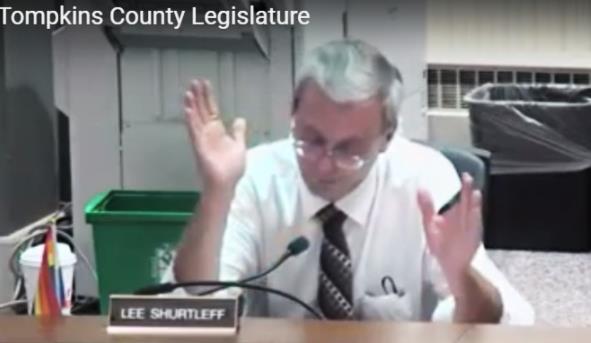
Rich John acknowledged up front how critics within and outside of legislative chambers might fault his initiative.
“This type of Resolution is subject to the criticism that it’s indulgent, and nobody will ever listen to us,” the Ithaca Democrat acknowledged. “Fair enough. But we do take an oath of office to support the Constitution of the United States, and it is within our remit to look at the Constitution and honor it. And we also have a job as Americans to petition Government when we see that we think there’s a need for change,” the Cornell adjunct law professor continued.
“I believe,” John said, “there is a need for change.”
****
Writer’s note: This author commented in support of Rich John’s Resolution at the start of Tuesday’s Legislature meeting.
###
Second Podunk Road Solar Farm Planned

by Robert Lynch, July 16, 2022
A year from now, as you approach the intersection of Podunk and Aiken Roads, you may find not one solar farm, but two.
Providing their first public disclosure of the company’s plans, representatives of East Light Partners presented the Enfield Town Board Wednesday (July 13) their proposal to build a 5 Megawatt solar farm southwest of the corner of Podunk and Aiken, an array that might stretch half the way south toward Mecklenburg Road.
The East Light proposal, still very preliminary and lacking any approvals from either the Town or NYSEG, would produce more than twice the power of the earlier-built “Delaware River Solar” array that stands a few hundred feet from the intersection’s northwest corner. But still, this newest proposal would generate only a third of the electricity that the forthcoming Norbut Solar project east of Enfield’s Applegate Road would produce.
“We don’t have an established footprint for the project.” Will Bliss, East Light’s Director of Engineering, cautioned the Town Board Wednesday. “We have to get some feedback from the utility first.”
However, as currently proposed, Bliss said East Light’s array would occupy approximately 30 acres of the weedy and lightly-wooded tract the company plans to acquire, land once part of a farm that the late former Sheriff, Robert Howard, operated. The County Clerk’s Office’s deed records list Larry and Janette Ward as the land’s current owners.
“It doesn’t contain any prime farmland,” Bliss assured the Board. The engineer acknowledged the tract, however, does include some wetlands.
East Light first disclosed its preliminary plans in an email to Enfield Town Board members June 29th. In its initial message, East Light did not indicate the project’s size or precise location.
Bliss Wednesday described East Light Partners as a “pretty small team, but well experienced in New York.” He said it operates 15 solar projects in New York State. Wendy De Wolf, one of the company’s founders, joined Bliss at the Board’s online meeting.
Nothing the company plans can be approved or built right away. Last December, the Enfield Town Board imposed a moratorium on the permitting of new commercial solar farms, a moratorium the Board extended in May to continue through early-December of this year. The Board imposed the moratorium principally to enable it to consider changes in how future projects would be taxed.
East Light’s representatives voiced little concern with the moratorium’s resulting delay.
“We’re going through all of the preliminary and supplemental introductory studies,” Bliss told the Board. He said NYSEG might not even decide until this fall whether East Light can attach to its grid. But if the utility approves connection and the moratorium lifts, he said the company might approach Enfield’s Planning Board this autumn. Given site plan approval, Bliss added, construction could commence in “late spring/early summer” 2023.
Utility interconnection, however, may become more than just a formality. By all appearances, East Light would add its generated energy to the same higher-capacity roadside lines that Norbut would also contribute its power to just a few miles away.
Last year, during the permitting process, Norbut scaled back its Applegate Road project from 20 Megawatts to 15, purportedly because NYSEG told it the higher output would have overtaxed the utility’s connection and switching apparatus. Now, however, East Light would add to the system the same amount of energy that Norbut was told to subtract. Viewing the numbers, Councilperson Robert Lynch (this writer) questioned East Light representatives on whether their project was even feasible.
“I can’t determine 100 per cent whether we’re able to connect,” Bliss admitted. Nonetheless, he added, “My understanding is that it is along a different circuit.”
To the naked eye, the lines linking Applegate Road with Podunk Road appear seamless. However, those lines also appear to extend west to Mecklenburg, and then to Reynoldsville. Planning Board Chair Dan Walker said he’d been told East Night’s output would head toward Montour Falls, rather than to Ithaca.
“You better be sure is all I can say,” Lynch cautioned East Light’s representatives.
****
But a second issue impacting East Light’s project, namely taxation, became the hotter topic and dominated much of Wednesday’s solar farm discussion. And it allowed Councilperson Jude Lemke to bring forth preliminary conclusions of the Renewable Energy Advisory Committee she chairs, findings reached by the committee during closed-door discussions that have taken place since the solar moratorium began.

For some 15 minutes, Lemke and East Light’s De Wolf wandered through the technicalities of solar farm taxation. They voiced competing opinions most of the time. Lemke said her committee had tentatively recommended to “opt-out” of an often-cited section of New York real estate law (Section 487). By contrast, De Wolf maintained the Town’s opting into the law’s chapter would best serve Enfield’s stated interests.
“I would highly, highly recommend you not opt out of 487,” De Wolf counseled Lemke.
Lemke’s intention, one shared by many Town Board members, would attempt to circumvent the Tompkins County Industrial Development Agency (IDA) as much as possible when taxing solar farms. The IDA last fall granted Norbut Solar a 30-year so-called “PILOT” tax abatement that Enfield Board members then concluded provided the Town too little compensation. The IDA also thwarted Enfield’s effort to impose a “Host Community Agreement” with Norbut, an agreement that would have provided the town a second funding stream.
“If we opt-out, then the IDA is cut out of the conversation, and we’re simply subject to local real estate taxation,” Lemke stated.
“If you opt out, we’ll absolutely go to the IDA” De Wolf countered. “If you stay in, I will work with you.”
As the East Light partner viewed the choices, an opt-in decision would provide Enfield more power to write a Town-friendly PILOT abatement. Opting out, she said, defaults that decision to the IDA. De Wolf maintained that the Renewable Energy Committee’s preferred choice, namely to subject future solar farms to traditional taxation, stands out of reach and might very well lose in court.
“The normal, separate property tax requests are not well-established, and they’re currently being challenged on the state level,” De Wolf said.
Yet to some, solar farms deserve no abatement at all, regardless of who writes it.
“We do not want any sort of PILOT Agreement,” Supervisor Stephanie Redmond insisted. “We want it taxed at the level that solar projects are taxed under the normal law.”
“Unfortunately,” De Wolf replied, “that doesn’t work.” With normal taxation, she said, projects don’t get built.
“That doesn’t matter, honestly,” Redmond rebutted.
“As for not being able to have a solar farm here,” Redmond continued, “that’s not really something… that we are in dire need of. We have so many solar farms coming here and wanting to develop on our property that we will go to the next company that actually wants to pay enough to have a project here.”
Lynch remarked that, in his opinion, “we got a raw deal from the IDA” with last year’s Norbut PILOT Agreement, one he’d rather not have repeated.
“We want to have more say,” Lynch commented. “We want to sit at the table, and if there’s a PILOT that has to be negotiated, we want to negotiate it, not have it done downtown.”
Totally apart from the East Light proposal, the Enfield Board Wednesday took a step to resolve one question that’s delayed an end to its ongoing solar moratorium. It authorized Lemke’s committee to send a draft Host Community Agreement to an attorney for review. That agreement might impact future projects, like East Light’s
###
Divided vote could give Redistricting Plan rocky ride
by Robert Lynch, July 9, 2022
It’s no secret that Mike Lane has never liked the redistricting plan for the Tompkins County Legislature that an independent commission handed up this spring. It calls for adding two more members to the current body of 14. That’s too big, Lane says. If anything, he’d like fewer people at the table. The commission would set membership at an even number, 16. Lane wants an odd number only; better that way, he says, to break ties.
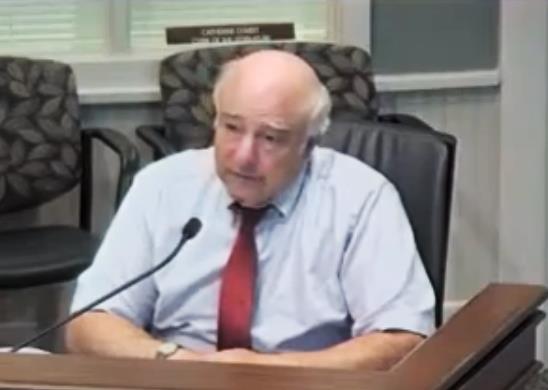
But early on it their five months of deliberations, members of the Tompkins County Independent Redistricting Commission (IRC), a creation of the County’s Charter, coalesced on a sixteen-district plan. Nothing else, members argued, really worked. Given the State’s new and tighter standards for population parity, alternative headcounts chopped municipalities or “communities of interest” to smithereens. In at least one rejected scenario, little Enfield would have it found itself represented by as many as three legislators, not merely the present two.
So when the IRC’s consensus 16-member recommendation wound its way to a key legislative committee Thursday (July 7), Lane attempted a roadblock. As the County Charter allows, the Legislature’s most senior member offered an alternative. Rather than accept the IRC’s plan and send it on to the full Legislature for an early-August Public Hearing and likely adoption, Lane wanted to toss the redistricting plan back to the Commission for retooling…. with explicit instructions. He’d direct the IRC to craft a proposal “having an odd number of legislative districts with 15 or fewer in number.”
Lane’s alternative directive failed, but only by a single vote on the five-member Government Operations Committee.” Following the defeat, by a similar 3-2 margin, the committee backed the plan the IRC had drafted. But the debate isn’t over. Lane promised to bring his alternative before the full Legislature when it takes comment—and will consider adopting the plan—August 2nd.
“We’re not in a hurry here; we’ve got time” Lane advised committee members Thursday, reminding them that any change in the Legislature’s size wouldn’t kick in until after the 2025 election. “I think we should return this to the Commission and ask them to look at an alternate plan.”
For most of its history, the County Legislature, and its forerunner, the Board of Representatives, has had 15 members. Only a decade ago did membership shrink to 14.
A larger Legislature, the Dryden Democrat argued, would be more expensive. And it “will add to our administrative requirements for our staff.”
Of course, although never stated aloud, a larger body would also dilute the power and influence of each elected member.
Lane found an ally in his throw-it-back argument, namely from freshman legislator Travis Brooks.
“I understand where Mike is coming from and I agree with him,” Brooks said in a crisp endorsement of Lane’s alternative.
But later, after Lane’s motion had failed, Brooks shared his grievance about the way the Commission redrew his City-based district so that it hugged Cayuga Lake’s western shoreline all the way to the Ulysses town line.
“It cut out the heart of my district, the Washington Park area,” complained Brooks, who, African-American, has found political support among the City’s minority population.
“I’m torn,” said Dryden’s Greg Mezey, whose vote proved pivotal in the committee’s support for the IRC plan. “Personally,” he said, pondering possible IRC reconsideration “I don’t know if we’re going to get a different result, or if we’re just asking volunteers who’ve spent a tremendous amount of time and took this process incredibly seriously to do work they’ve already done and already evaluated.”

Indeed, for Mike Lane and his supporters, the rules anchored in the Charter work against them. Even if the full Legislature sent the redistricting plan back to the IRC, the Commission could simply reaffirm it. And should it do so, barring a successful challenge in court, the Charter might force the Legislature to accept the 16-member plan, like it or not.
“I don’t particularly agree that an even number of districts is a problem,” Committee Chair Amanda Champion said as she steered members away from Lane’s criticism.
What made it tough this year for the IRC to satisfy all interests in its once-in-a-decade redistricting cycle is a more rigid State standard—perhaps enacted by accident—that commands population equality among districts be twice as strict as the U.S. Supreme Court demands. What’s more, City of Ithaca officials have leaned heavily on the IRC to draw City-based legislative district lines to follow those of Ithaca’s five wards, a request no law demanded it do.
“I don’t think we should let the City drive us in our redistricting,” Lane said Thursday. “We’ve given a little too much to the City here, and not to the County as a whole.”
If Lane and Brooks can draw six allies to their side when the full Legislature takes up redistricting in August, a citizen-drawn commission that thought its job was over could be forced to convene at least one more time.
Ulysses-Enfield’s Anne Koreman thinks the full Legislature is where Lane’s proposal deserves its fullest vetting.
We need a “robust discussion with all of us to see where we land on this,” Koreman told the committee. Beyond that, she didn’t tip her hand.
****
A second political flash point, which could have drawn fireworks at Thursday’s meeting, was, in essence, batted aside for another day.
At the Legislature’s June 21st meeting, Committee Chair Amanda Champion, out of the blue, announced she planned committee discussion of establishing first-ever term limits for County lawmakers. If set, such limits would undercut most severely seven-term legislator Lane in any future bid he might make for reelection. It could also target Lansing’s Mike Sigler.
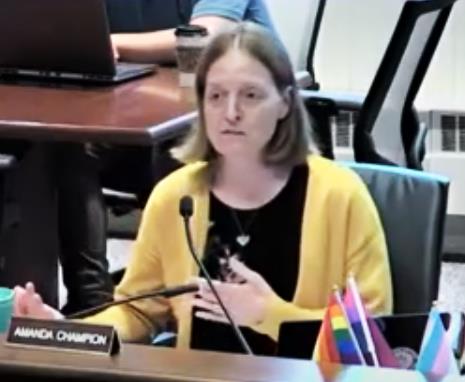
Limited by the clock, and left somewhat exhausted by the redistricting discussion, committee members, aside from Lane, put off confronting the term limits issue head-on. Nonetheless, a majority signaled they’d welcome further pursuit of Champion’s initiative, if only to give it a full airing.
“I think it’s important to have this conversation as a healthy organization,” Greg Mezey remarked, But noting that to his knowledge only three of the Legislature’s 14 members are serving beyond two terms, he added, “I think we’re doing OK right now.”
But in defense of term limits, Champion defined her role as an in-the-moment advocate.
“This is not my job. This is not my career. This is not my goal to have this seat for a very long time,” Champion told her committee. “My goal is to represent my community right now.”
Champion maintained that if a Republican were representing her district, as she said one had in the past, he or she would not be representing “my community.” Her comment implied that the Ithaca Town Democrat considers herself representing only chosen constituents, not everyone.

While open to further discussion of term limits, though not sold on their need, Ithaca’s Travis Brooks asked, “If this isn’t something that our constituents are asking (for), I’m not sure how we got here to begin with.”
And Mike Lane, while receptive to broadening the term limits issue to a broader examination of County Government restructuring, maintained the lack of public demand for term limits also leads him to question them.
“Leave it to the voters,” Lane told the committee. “I’m not hearing it from constituencies asking us to do something like this.”
“People can always not run again,” Lane said. “And they can get defeated.” And referencing how Dryden’s voters once turned him out of office, only to reelect him a few years later, the Legislature’s longest-tenured member added, “and I’m a perfect example of that.”
###
Mags, Cops eyed to guard Human Services Building
by Robert Lynch, July 8, 2022
It’s a sign that Ithaca’s west end has become a more dangerous place to live and work.
Exactly one month after Tompkins County Administrator Lisa Holmes brought the County Legislature to silence as she and the Legislature’s Chair related shootings and then a stabbing near the entrance of West State Street’s Human Services Building, a legislative committee Thursday recommended the County purchase a magnetometer and retain two armed Sheriff’s deputies to screen the building’s visitors.
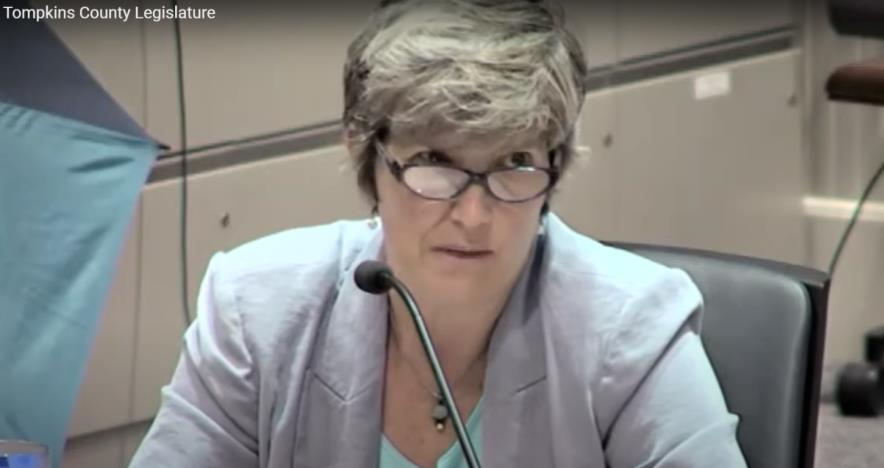
The increased security measures, as well as the financial transfers to fund them, will likely reach the full County Legislature July 19th.
“For years, we at the County have prided ourselves on the accessible nature of our services and our wanting to make those services as barrier-free as possible,” Holmes told the Legislature’s Government Operations Committee prior to Thursday’s vote. “That’s commendable, and that commitment hasn’t changed.”
“But I believe we’re at a point now in the area of the Human Services Building,” Holmes continued, “where I believe a higher level of security is warranted and would improve the environment and the access for the public; the safety and security of the public and the staff.”
The hastily-submitted resolution that secured the committee’s unanimous support would purchase for the building a $16,000 magnetometer and fund two armed deputies, their cost estimated at $258,000 annually. The resolution suggested that State or Federal sources could reimburse 70 per cent of the security measures’ cost.
Most agree the tipping point for those working at the Human Services Building occurred May 27th when an assailant shot and wounded two men at a house a close distance away. Then, on June 6th, a stabbing occurred on the sidewalk near the building’s entrance.
Addressing the County Legislature one day after the stabbing, Holmes reported that several who worked in the building “expressed feeling stressed and traumatized” by the twin incidents.
Holmes apologized to the Government Operations Committee Thursday for not submitting her resolution sooner, explaining she’d been focusing attention on “the most recent incidents,” a comment that suggested that unspecified additional violent acts may have occurred there.
“We are seeing and understanding that many people accessing services in the building may be carrying weapons for their own protection,” Holmes warned the committee, their actions a violation of County policy. “But we can’t screen for weapons currently,” the Administrator acknowledged.
If the upgrades occur, the Human Services Building, which houses social services and probation offices, would become only the second, civilian-staffed Tompkins County office complex to employ metal detectors. Under a long-standing State mandate, court personnel screen both visitors and staff at the Tompkins County Courthouse.
“I think the reality is that we have been seeing a real increase in incidents and that doesn’t seem to be subsiding,” Kit Kephart, Commissioner of Social Services, told the committee, relating the security status at her complex. “We are seeing increased need from the community for our services, but we also are seeing people who are in rougher shape.”

Kephart referenced those with mental health issues, “impairment from substances,” and homelessness. The commissioner explained that many of the unhoused believe they need to arm themselves to protect themselves on the streets.
For some building employees, the prime benefit of the new apparatus and armed protection could be peace of mind.
“I do know that when we had deputies down there for a week after the last major incident (the shootings and stabbing) from what I heard from the limited amount of employees there (was) that it did make a difference,” Sheriff Derek Osborne told lawmakers. Kephart agreed.
But the heightened security will come with a cost, in both money and manpower. And that bothered legislator Mike Sigler. Though not on the committee, the Lansing Republican suggested he’d oppose the resolution once it reaches the Legislature’s floor. He’d prefer the County hire private security guards instead.
“I can’t justify putting two deputies to protect our people,” namely County employees, Sigler said. Deputies are “there to protect everybody, not just our people,”
Osborne conceded his department would have to scramble to meet the new downtown security demand without pulling officers off the normal road patrol. The department could train new full-time recruits, or enlist part-time retirees. “It’s doable,” said Osborne, yet “either way it’s going to have a challenge.”
Committee member Mike Lane made clear Sheriff’s deputies should handle the building’s security, not private contractors.
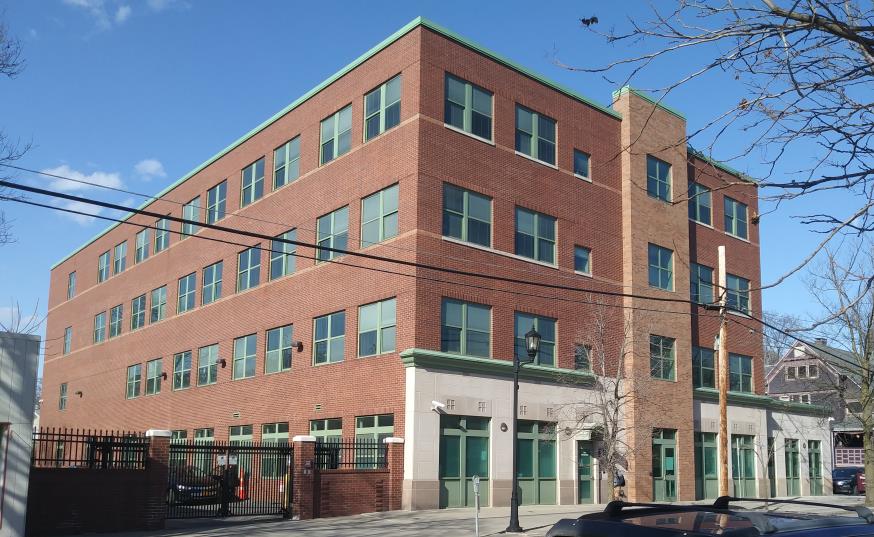
“I’m really, really concerned that if we hired armed private security, and we had an incident (namely, a shooting), what our liability would be in that kind of a situation because they’re not direct employees of the County, but rather contract employees,” Lane said.
There’s a second problem with using contract staff, one the committee danced around Thursday to avoid going behind closed doors. When some other counties have hired out for security, deputy unions have rebelled. And according to Holmes, when they did, the unions won and the counties lost.
But a question remaining unanswered, a question committee Chair Amanda Champion sought to set aside for a later day, was what burden the City of Ithaca must bear for bringing order to the increasingly lawless, wild, west end.
“The discussion we need to start having with the City,” Ithaca legislator Travis Brooks remarked, is “about cleaning up that area.”
“Where’s the City in all this?” Dryden’s Greg Mezey asked. “This conversation has to be at the Common Council level. There’s a problem, and it’s another example of the City handing the problem or the cost burden to the County.”
In other committee action Thursday:
- The Government Operations Committee accepted and forwarded to the full Legislature the County Independent Redistricting Commission’s recommendation to expand the Legislature from 14 to 16 members beginning in 2026. But approval only came after the committee rejected by just one vote legislator Mike Lane’s substitute resolution that would have kicked the redistricting plan back to the Commission, directing it revise it to propose an odd-numbered Legislature with 15 or fewer members. (A separate story on this matter will be posted.)
- Over Lane’s other objection, the committee granted future life to Chair Amanda Champion’s initiative to consider term limiting legislators. The committee took no action, but a majority of members expressed interest in discussing term limits further.
- And with no discussion, the committee unanimously recommended to end its COVID-19 testing mandate for unvaccinated County employees. If approved by the full Legislature, County assistance to municipalities with their own mandates might end as well.
###

